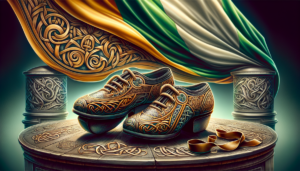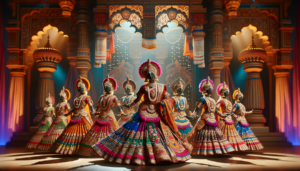Introduction to Flamenco
Flamenco is a captivating art form that originated in the southern regions of Spain, particularly in Andalusia. It is a unique blend of dance, music, and singing that has become an integral part of Spanish culture. Flamenco is known for its emotional intensity, intricate footwork, and passionate performances that leave audiences spellbound.
The roots of flamenco can be traced back to the Roma people, also known as Gitanos, who settled in Spain during the 15th century. Over time, flamenco evolved, incorporating influences from various cultures, including Arabic, Jewish, and African, resulting in a rich and diverse artistic expression.
What is Flamenco?
At its core, flamenco is a traditional Spanish dance that is accompanied by music and singing. The dance is characterized by expressive movements, intricate footwork, and a strong sense of rhythm. Flamenco dancers, known as bailaores or bailaoras, use their entire bodies to convey emotions, from the delicate movements of their hands to the powerful stomping of their feet.
Flamenco music is equally important, with the guitar playing a central role. The flamenco guitar, known as toque, provides the melodic foundation for the dance and singing. Guitarists, or tocaores, use a variety of techniques, including fingerpicking and strumming, to create the distinctive sound of flamenco music.
Origins and History of Flamenco
The exact origins of flamenco remain somewhat mysterious, but it is believed to have emerged from the Roma communities in Andalusia. These communities faced persecution and marginalization, and flamenco became a means of expressing their struggles, joys, and sorrows.
Over the centuries, flamenco has evolved and gained recognition as a significant part of Spanish cultural heritage. It has been influenced by various historical events, such as the Moorish occupation of Spain and the Spanish Inquisition, which have shaped its musical and lyrical content.
Today, flamenco is celebrated not only in Spain but also around the world. It has been recognized by UNESCO as an Intangible Cultural Heritage of Humanity, acknowledging its cultural significance and the need to preserve this art form for future generations.
Elements of Flamenco
Flamenco Dance
Flamenco dance is the visual embodiment of the music and emotions expressed in flamenco. It is a highly expressive and improvisational dance form that requires great skill, passion, and technical precision. Flamenco dancers use their entire bodies to convey a wide range of emotions, from joy and love to pain and sorrow.
The dance is characterized by intricate footwork, known as zapateado, which involves rapid, rhythmic stomping of the feet. The upper body movements are equally important, with the dancers using their arms, hands, and facial expressions to convey the emotional depth of the performance.
Flamenco dancers often wear traditional costumes, which include long, flowing dresses for women and tight-fitting pants and jackets for men. These costumes enhance the visual appeal of the dance and allow for greater freedom of movement.
Flamenco Music
Flamenco music is the heartbeat of this art form, providing the rhythmic and melodic foundation for the dance and singing. The flamenco guitar is the primary instrument, and guitarists use a variety of techniques to create the distinctive sound of flamenco music.
In addition to the guitar, other instruments such as the cajon (a box-shaped percussion instrument), palmas (handclaps), and castanets are often used to provide rhythmic accompaniment. The combination of these instruments creates a rich and layered sound that is both energetic and emotionally charged.
Flamenco singing, known as cante, is another essential element of flamenco music. Singers, or cantaores, use their voices to express deep emotions, often improvising lyrics and melodies to convey the desired mood. The singing style is characterized by powerful, guttural sounds and emotional intensity.
Emotional Intensity in Flamenco
One of the defining characteristics of flamenco is its emotional intensity. Flamenco performances are not merely a display of technical skill; they are a means of expressing the deepest human emotions, from love and joy to pain and sorrow.
The emotional intensity of flamenco is evident in every aspect of the art form, from the passionate movements of the dancers to the soulful singing and the haunting melodies of the guitar. Flamenco artists pour their hearts into their performances, creating an atmosphere that is both captivating and emotionally charged.
This emotional depth is rooted in the historical and cultural context of flamenco. The art form emerged from the struggles and hardships faced by the Roma people and other marginalized communities in Spain. Flamenco became a means of expressing their experiences, their triumphs, and their sorrows, and this emotional authenticity continues to be a defining feature of flamenco today.
Notable Flamenco Performances and Festivals
Ballet Flamenco Andalucia
The Ballet Flamenco Andalucia is a renowned flamenco dance company that has captivated audiences around the world with its stunning performances. The company was founded in 1994 and is based in Seville, the heartland of flamenco.
Under the artistic direction of Rafaela Carrasco, the Ballet Flamenco Andalucia has created numerous productions that showcase the beauty, power, and emotional depth of flamenco dance. The company’s performances are known for their technical precision, artistic innovation, and ability to convey the essence of flamenco culture.
One of the company’s most notable performances was their appearance at the Flamenco Festival in New York City Center. This annual festival brings together some of the world’s most talented flamenco artists, and the Ballet Flamenco Andalucia’s performance was a highlight of the event.
Flamenco Festival at New York City Center
The Flamenco Festival at New York City Center is one of the most prestigious flamenco events in the world. Held annually, the festival showcases the best of flamenco dance, music, and singing, attracting audiences from around the globe.
The festival features performances by renowned flamenco artists, as well as up-and-coming talents. It provides a platform for both traditional and contemporary interpretations of flamenco, showcasing the art form’s rich heritage and its continued evolution.
In addition to the performances, the Flamenco Festival also includes workshops, lectures, and other educational events that provide insights into the history, culture, and techniques of flamenco. These events offer a deeper understanding of the art form and its significance in Spanish culture.
Flamenco in the Digital Age
Popular Flamenco Videos on YouTube
In the digital age, flamenco has found a new platform for reaching global audiences through YouTube. Many flamenco artists and enthusiasts have turned to the video-sharing website to showcase their performances and share their love for the art form.
One notable example is the video titled “Amazing Flamenco,” which has garnered over 5.5 million views on YouTube. Uploaded by the channel Tristesse1, the video features a mesmerizing flamenco performance that showcases the skill and passion of the dancers and musicians.
Another popular flamenco video on YouTube is a performance by the Ballet Flamenco Andalucia at the Flamenco Festival in New York City Center. The video, uploaded by the official NYC City Center channel, has been viewed more than 5.3 million times, reflecting the global appeal and interest in flamenco.
Impact of Digital Platforms on Flamenco
The rise of digital platforms like YouTube has had a significant impact on the world of flamenco. These platforms have made it easier than ever for flamenco artists to reach a wider audience and share their performances with people around the world.
For audiences, YouTube and other digital platforms provide access to a vast library of flamenco content, allowing them to discover new artists, learn about the history and culture of flamenco, and enjoy performances from the comfort of their own homes. This has helped to increase the visibility and appreciation of flamenco on a global scale.
Digital platforms have also created new opportunities for flamenco artists to connect with their fans and build their careers. Many artists use social media to engage with their audiences, share behind-the-scenes glimpses of their performances, and promote their work.
However, it is important to note that while digital platforms have brought many benefits to the world of flamenco, they cannot replace the experience of live performances. The emotional intensity and energy of a live flamenco show cannot be fully captured through a screen. Therefore, it is crucial to continue supporting and attending live flamenco performances to ensure the art form’s preservation and growth.
Conclusion
Flamenco is a captivating and deeply emotional art form that has captured the hearts of people around the world. From its origins in the Roma communities of Andalusia to its current status as a globally recognized cultural treasure, flamenco has evolved and adapted while remaining true to its roots.
The combination of dance, music, and singing creates a powerful and unforgettable experience that speaks to the human soul. Flamenco dancers, with their intricate footwork and expressive movements, convey a wide range of emotions, while the music and singing provide the perfect accompaniment to their performances.
Notable events like the Flamenco Festival at New York City Center and performances by the Ballet Flamenco Andalucia showcase the best of flamenco and help to promote the art form on a global stage. In the digital age, platforms like YouTube have made it easier than ever for people to discover and enjoy flamenco performances from around the world.
As we move forward, it is important to continue supporting and celebrating flamenco as a vital part of Spain’s cultural heritage. By attending live performances, engaging with flamenco content online, and spreading appreciation for this beautiful art form, we can ensure that flamenco continues to thrive and inspire future generations.






